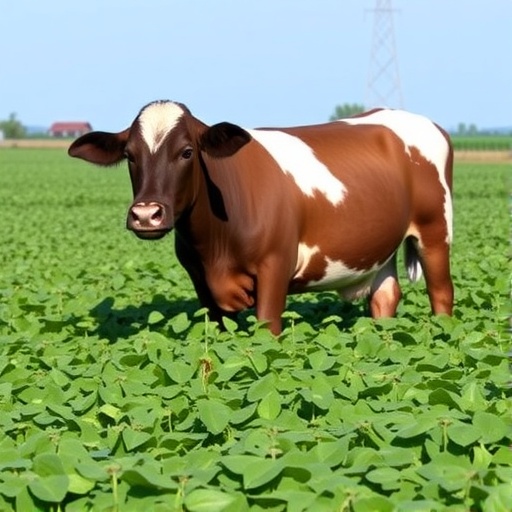In an exciting development for livestock nutrition, recent research has spotlighted duckweed, specifically the species Lemna gibba, as a sustainable and nutrient-rich feed option for ruminant animals. This innovative approach, explored by researchers Chaji and Pormhammad, could lead to breakthroughs in the efficiency of animal husbandry and food production, especially in regions where traditional feed sources are scarce or costly. The findings of this study, published in 2025, offer promising insights into the nutritional evaluation and fermentation characteristics of duckweed in the diets of cattle, sheep, and goats, addressing the growing global demand for sustainable agricultural practices.
Duckweed is a floating aquatic plant often overlooked in animal feed discussions. However, its rapid growth rate, minimal resource requirements, and high protein content make it an ideal candidate for ruminant diets. Lemna gibba, one of the most common duckweed species, has been evaluated for its ability to serve as a potential alternative to conventional feed grains such as corn and soybean meal. As ruminants rely heavily on fibrous plant materials, understanding the fermentation characteristics of duckweed is vital for determining its fitness as a feed source.
The study investigates the nutritional profile of Lemna gibba, particularly focusing on its protein, fiber, and mineral content. Preliminary analyses suggest that this aquatic plant is rich in essential amino acids, making it a potent protein substitute. Furthermore, the digestibility of its fiber content offers ruminants a source of energy while supporting overall gut health. This aligns well with the increasing consumer demand for sustainably raised animal products that lower the environmental impact of livestock farming.
Fermentation is a critical process in ruminant digestion, wherein microorganisms in the stomachs of these animals break down plant materials into digestible nutrients. The study’s authors meticulously examined how duckweed interacts with these fermentation processes, highlighting its potential to optimize nutrient uptake. By feeding ruminants duckweed, farmers could enhance feed efficiency and, in turn, reduce the carbon footprint associated with raising livestock. The promising results from controlled fermenter trials provide insight into how Lemna gibba could alter the microbial ecosystem within ruminant digestive tracts.
Moreover, the aquaculture of duckweed presents a sustainable method to produce animal feed. This practice requires significantly less land and water compared to traditional farming methods, making it an attractive solution for meeting the nutritional needs of livestock within an environmentally responsible framework. As climate change continues to amplify pressures on global food systems, integrating duckweed into ruminant diets could contribute to sustainable agriculture initiatives aimed at reducing greenhouse gas emissions.
In addition to nutritional and environmental implications, the economic benefits of utilizing duckweed in livestock diets are noteworthy. Farmers facing rising feed costs could find financial relief from incorporating this plant into their feeding strategies. As Lemna gibba can thrive in nutrient-rich waters, it can be cultivated in areas otherwise unsuitable for traditional crops. The prospect of lowering feed expenses while enhancing animal health creates a marked incentive for farmers to explore alternative feed resources.
The research also reflects a growing trend in exploring unconventional feed sources for livestock, challenging conventional wisdom regarding primary feed staples. As scientists and agriculturalists confront the reality of diminishing arable land and the ramifications of intensive farming, the quest for alternative nutrition sources becomes increasingly pertinent. The findings from Chaji and Pormhammad contribute to this critical discourse by validating the nutritional viability of an often-overlooked plant.
By integrating such innovations, the food production industry can work toward achieving a more resilient agricultural framework. The compelling aspects of duckweed encourage researchers and producers alike to delve deeper into its applications, fostering a spirit of exploration and innovation. As more studies emerge elucidating the benefits of duckweed, the potential to revolutionize feed practices expands, creating ripples throughout the agricultural economy.
The implications of this research extend beyond mere livestock nutrition; they touch upon food security on a global scale. With an ever-increasing population and rising demands for protein sources, ensuring that livestock is fed efficiently and sustainably is of utmost importance. Recognizing the role of aquatic plants such as duckweed in addressing these challenges opens new pathways for research and application in agricultural science.
As discussions surrounding food resource management continue to evolve, embracing the findings of such studies may enhance the overall sustainability and productivity of modern farming practices. The shift towards incorporating plants like Lemna gibba could serve as a template for future initiatives aimed at redefining traditional feeding regimes. The work of Chaji and Pormhammad stands as a testament to the innovative solutions that nature can provide, revealing how we can adapt our practices to better align with environmental preservation goals.
In conclusion, the nutritional evaluation and fermentation characteristics of Lemna gibba showcase the potential it holds for transforming ruminant diets. With its rich nutrient profile, compatibility with fermentation processes, and capacity to promote sustainable farming practices, duckweed emerges as a promising alternative feed source. As further exploration and experimentation continue, the agricultural landscape may witness a shift towards more sustainable and economically viable options for livestock feed, potentially reshaping the industry for years to come.
This research reminds us of the value of thinking outside the box when addressing challenges in food production and animal husbandry. By exploring diverse feed sources, we can better navigate the complexities of modern agriculture while fostering a healthier planet for future generations. As we push the boundaries of agricultural research, the findings regarding duckweed not only inspire curiosity but encourage action toward more sustainable farming practices worldwide.
Subject of Research: Nutritional Evaluation and Fermentation Characteristics of Duckweed in Ruminant Diets
Article Title: Nutritional evaluation and fermentation characteristics of duckweed (Lemna gibba) in ruminant diets
Article References:
Chaji, M., Pormhammad, A. Nutritional evaluation and fermentation characteristics of duckweed (Lemna gibba) in ruminant diets.
Discov Anim 2, 35 (2025). https://doi.org/10.1007/s44338-025-00079-6
Image Credits: AI Generated
DOI: 10.1007/s44338-025-00079-6
Keywords: Duckweed, Ruminant Nutrition, Sustainable Feed, Lemna gibba, Fermentation, Aquatic Plants, Livestock Feed Alternatives, Environmental Sustainability, Food Security




